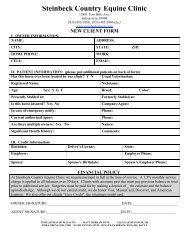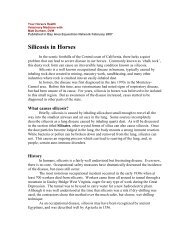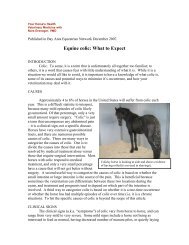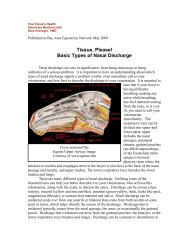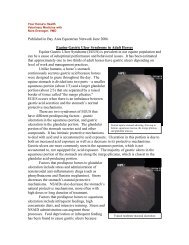Overview of Ringbone in Horses - Steinbeck Country Equine Clinic ...
Overview of Ringbone in Horses - Steinbeck Country Equine Clinic ...
Overview of Ringbone in Horses - Steinbeck Country Equine Clinic ...
You also want an ePaper? Increase the reach of your titles
YUMPU automatically turns print PDFs into web optimized ePapers that Google loves.
Your Horse's Health<br />
Veter<strong>in</strong>ary Medic<strong>in</strong>e with<br />
Timothy G. Eastman, DVM, DACVS, MPVM<br />
Published <strong>in</strong> Bay Area Equestrian Network March 2008<br />
Figure 1. Note the smooth borders <strong>of</strong> the<br />
bones along the front <strong>of</strong> the Pastern Jo<strong>in</strong>t <strong>of</strong><br />
this normal horse.<br />
<strong>Overview</strong> <strong>of</strong> <strong>R<strong>in</strong>gbone</strong> <strong>in</strong> <strong>Horses</strong><br />
The pastern jo<strong>in</strong>t, also known as the<br />
proximal <strong>in</strong>terphalangeal jo<strong>in</strong>t, is a relatively<br />
common source <strong>of</strong> lameness <strong>in</strong> horses (Figure<br />
1). Degenerative jo<strong>in</strong>t disease/arthritis <strong>of</strong> this<br />
jo<strong>in</strong>t is commonly referred to as high r<strong>in</strong>gbone.<br />
Low r<strong>in</strong>gbone refers to the same type <strong>of</strong><br />
degenerative jo<strong>in</strong>t disease <strong>of</strong> the c<strong>of</strong>f<strong>in</strong> jo<strong>in</strong>t and<br />
is much less common. <strong>Horses</strong> afflicted with high<br />
r<strong>in</strong>gbone are difficult to keep sound. The area is<br />
similar to the lower hock jo<strong>in</strong>ts <strong>in</strong> that it is a<br />
"high-load/low motion" jo<strong>in</strong>t, mean<strong>in</strong>g the jo<strong>in</strong>t is<br />
subjected to a lot <strong>of</strong> pressure but undergoes<br />
very little movement. Unlike the lower hock<br />
jo<strong>in</strong>ts, the pastern jo<strong>in</strong>t does not respond consistently to <strong>in</strong>tra-articular <strong>in</strong>jections.<br />
The diagnosis <strong>of</strong> high r<strong>in</strong>gbone is based on localiz<strong>in</strong>g the source <strong>of</strong> the<br />
lameness to the pastern jo<strong>in</strong>t with nerve and/or jo<strong>in</strong>t blocks. Lameness can be<br />
classified as m<strong>in</strong>or and only apparent with extreme exercise or severe enough to<br />
cause lameness at a walk. Radiographs and ultrasound are useful <strong>in</strong> confirm<strong>in</strong>g<br />
the diagnosis and determ<strong>in</strong><strong>in</strong>g the severity <strong>of</strong> the disease. Radiographically you<br />
see new bony growth along the front and the sides <strong>of</strong> the jo<strong>in</strong>t (figure 2).<br />
These bony prom<strong>in</strong>ences can sometimes<br />
be seen and felt prior to radiographs dur<strong>in</strong>g the<br />
physical exam<strong>in</strong>ation. If the disease was traumatic<br />
<strong>in</strong> orig<strong>in</strong>, ultrasound can be particularly useful <strong>in</strong><br />
identify<strong>in</strong>g any concurrent s<strong>of</strong>t-tissue <strong>in</strong>juries<br />
complicat<strong>in</strong>g the prognosis. A complete series <strong>of</strong><br />
radiographs is necessary to determ<strong>in</strong>e the severity<br />
<strong>of</strong> the disease as the sides <strong>of</strong> the jo<strong>in</strong>t can only be<br />
seen on oblique views. Quarter <strong>Horses</strong> are<br />
predisposed to r<strong>in</strong>gbone due to the rotational<br />
forces they exert on their lower limbs dur<strong>in</strong>g the<br />
sudden stopp<strong>in</strong>g and turn<strong>in</strong>g common <strong>in</strong> Western<br />
Performance. Treatment <strong>of</strong> r<strong>in</strong>gbone can be<br />
Figure 2. Compare the new bony growth<br />
along the front <strong>of</strong> this arthritic pastern<br />
jo<strong>in</strong>t to the normal one <strong>in</strong> figure 1.<br />
divided <strong>in</strong>to medical and surgical options. Medical management <strong>of</strong> r<strong>in</strong>gbone is<br />
aimed at slow<strong>in</strong>g down the progression <strong>of</strong> cartilage degeneration and reduc<strong>in</strong>g<br />
pa<strong>in</strong> and <strong>in</strong>flammation associated with the condition. Help<strong>in</strong>g to "ease the<br />
breakover" <strong>of</strong> the foot will decrease the forces subjected to the front <strong>of</strong> the jo<strong>in</strong>t<br />
and can be accomplished by a farrier "squar<strong>in</strong>g" the toe and "roll<strong>in</strong>g" the shoe.
Like any lameness condition, there are many ways to shoe for the same<br />
problem. Anti-<strong>in</strong>flammatories like Phenylbutazone ("bute") are used to decrease<br />
<strong>in</strong>flammation associated with acute flare-ups <strong>of</strong> the condition and to manage<br />
horses on a long-term basis. Many horses with r<strong>in</strong>gbone can be sound enough<br />
for light use by giv<strong>in</strong>g bute before and after exercise. Oral jo<strong>in</strong>t supplements<br />
alone are unlikely to be sufficient to provide relief but are thought by some to<br />
slow down the progression <strong>of</strong> the disease. More aggressive jo<strong>in</strong>t<br />
supplementation would <strong>in</strong>clude Legend? and/or Adequan?. Legend is an <strong>in</strong>travenous<br />
form <strong>of</strong> hyaluronic acid which is important <strong>in</strong> lubrication <strong>of</strong> jo<strong>in</strong>ts and is an<br />
essential component <strong>of</strong> jo<strong>in</strong>t fluid. Some horses with r<strong>in</strong>gbone will be sound<br />
enough for athletic use with Legend therapy alone. Adequan is an <strong>in</strong>tra-muscular<br />
<strong>in</strong>jection and is thought to delay the progression <strong>of</strong> cartilage degeneration.<br />
Inject<strong>in</strong>g the pastern jo<strong>in</strong>t is not reward<strong>in</strong>g as consistently as some other jo<strong>in</strong>ts<br />
but should be attempted to evaluate an <strong>in</strong>dividual horse's response. There is<br />
tremendous variability with regards to how long an <strong>in</strong>dividual horse will respond<br />
to pastern jo<strong>in</strong>t <strong>in</strong>jections.<br />
If controll<strong>in</strong>g the disease with anti-<strong>in</strong>flammatories, shoe<strong>in</strong>g changes and<br />
jo<strong>in</strong>t therapy is not sufficient to allow pa<strong>in</strong> free performance, surgically fus<strong>in</strong>g the<br />
jo<strong>in</strong>t may be the only option to provide pa<strong>in</strong> free performance. While this<br />
procedure <strong>in</strong>volves a major surgery, it <strong>of</strong>fers the possibility <strong>of</strong> complete return to<br />
work and relief from pa<strong>in</strong> for many horses. Research has shown that 2 out <strong>of</strong> 3<br />
horses with r<strong>in</strong>gbone <strong>of</strong> the forelimbs and greater than 4 out <strong>of</strong> 5 horses with<br />
h<strong>in</strong>dlimbs affected will be sound enough for athletic use with surgical fusion. This<br />
jo<strong>in</strong>t is fused with a comb<strong>in</strong>ation <strong>of</strong> plates and screws (Figure 3). Typically horses<br />
are ma<strong>in</strong>ta<strong>in</strong>ed <strong>in</strong> a cast for several weeks, then a bandage and stall rest for<br />
several months prior to return<strong>in</strong>g to full work.<br />
Figure 3. Horse with a<br />
surgically fused pastern jo<strong>in</strong>t.<br />
Figure 3. Horse with a surgically fused<br />
pastern jo<strong>in</strong>t.<br />
As with any lameness condition, your<br />
veter<strong>in</strong>arian and farrier need to work together to<br />
provide your horse with the highest level <strong>of</strong><br />
soundness possible and to help you determ<strong>in</strong>e<br />
the best course <strong>of</strong> action for your particular<br />
horse.
Tim G. Eastman DVM, DACVS, MPVM was raised <strong>in</strong> Monterey County California<br />
where his family had deep roots <strong>in</strong> the local horse <strong>in</strong>dustry. Like many<br />
veter<strong>in</strong>arians, he decided to become an equ<strong>in</strong>e veter<strong>in</strong>arian at a very young age.<br />
He obta<strong>in</strong>ed a degree <strong>in</strong> Animal Science at Cal Poly San Luis Obispo and a<br />
bus<strong>in</strong>ess m<strong>in</strong>or. He also obta<strong>in</strong>ed a doctorate <strong>in</strong> Veter<strong>in</strong>ary Medic<strong>in</strong>e from the<br />
University <strong>of</strong> California at Davis <strong>in</strong> 1996' as well as a Master's Degree <strong>in</strong><br />
Preventative Veter<strong>in</strong>ary Medic<strong>in</strong>e. He performed a one year <strong>in</strong>ternship at Littleton<br />
Large Animal Cl<strong>in</strong>ic <strong>in</strong> Littleton Colorado and then a 3 year surgical residency at<br />
Texas A&M University <strong>in</strong> College Station Texas . He met his wife, Alexandra<br />
(Alex) <strong>in</strong> veter<strong>in</strong>ary school and got married dur<strong>in</strong>g his surgical residency. They<br />
now work together as co-owners <strong>of</strong> Ste<strong>in</strong>beck <strong>Country</strong> Equ<strong>in</strong>e Cl<strong>in</strong>ic <strong>in</strong> Sal<strong>in</strong>as<br />
California.



